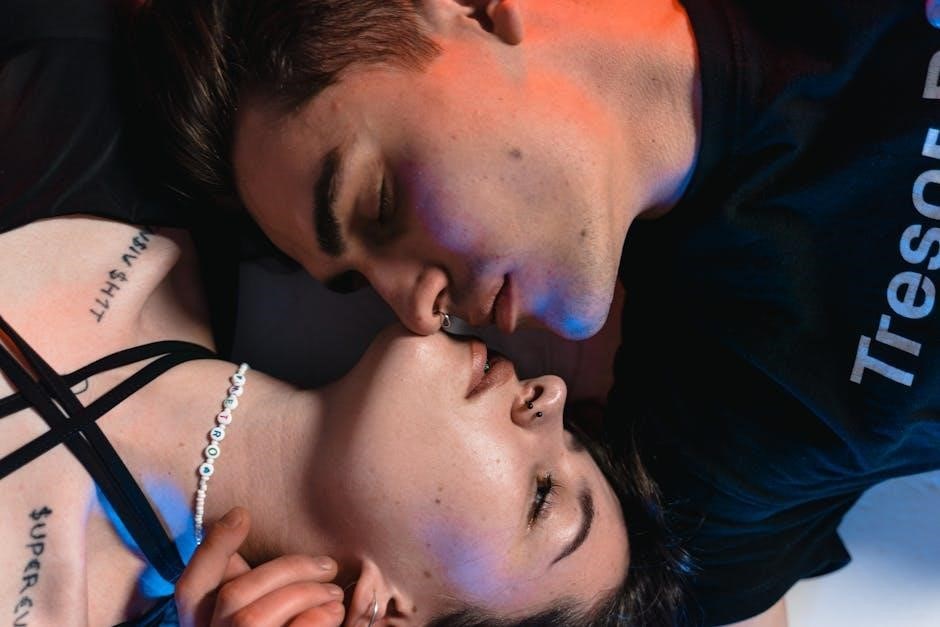Young’s Double Slit Experiment, conducted in 1801, demonstrated light’s wave nature by creating an interference pattern through two slits, proving wave properties of light.
1.1 Historical Context and Importance
Young’s Double Slit Experiment, conducted in 1801, was a landmark study that challenged the prevailing corpuscular theory of light proposed by Newton. At the time, the nature of light was debated, with supporters of both wave and particle theories. Young’s innovative approach used sunlight passed through two closely spaced slits, producing an interference pattern on a screen. This experiment provided conclusive evidence for the wave nature of light, supporting the earlier hypotheses of Huygens. The results were initially met with skepticism but later became foundational for modern physics, including quantum mechanics. This experiment marked a turning point in understanding light and wave-particle duality, influencing centuries of scientific inquiry.
1.2 Objective of the Experiment
The primary objective of Young’s Double Slit Experiment was to determine the nature of light by observing whether it exhibited wave-like or particle-like properties. By passing monochromatic light through two parallel slits, Young aimed to test the wave theory of light, which predicted that the light waves from each slit would interfere with each other. This interference would result in a pattern of bright and dark fringes on a screen, providing evidence for the wave nature of light. Additionally, the experiment sought to measure the wavelength of light and demonstrate the principles of superposition and interference, which are fundamental to wave behavior. This setup allowed Young to challenge the corpuscular theory and provide a clear understanding of light’s wave characteristics.

Experimental Setup and Apparatus
The experiment involves a monochromatic light source, two parallel slits, and a screen. The slits are narrowly spaced, and light passing through them creates an interference pattern on the screen.
2.1 Description of the Double Slit Apparatus
The double slit apparatus consists of a light source, two parallel slits cut into an opaque screen, and a detector or observation screen. The slits are spaced closely, typically in the order of millimeters, to ensure proper interference. The light source emits monochromatic or coherent light, essential for clear interference patterns. When the light passes through the slits, it diffracts, creating wavefronts that interfere constructively and destructively. A distant screen or photodetector is placed to capture the resulting pattern, which appears as bright and dark fringes. This setup is simple yet crucial for demonstrating wave properties of light.
2.2 Light Source and Slit Configuration
The experiment uses a monochromatic or coherent light source to ensure uniform wavelength and phase consistency. The light passes through two parallel slits, typically spaced a few millimeters apart, cut into an opaque barrier. The slits act as coherent sources, producing wavefronts that interfere. The slit width and separation are critical; narrower slits increase diffraction, while wider spacing enhances fringe clarity. Modern setups often use lasers for coherence and brightness. The light source’s wavelength and slit dimensions determine the interference pattern’s scale, with smaller wavelengths producing closer fringes. Proper alignment ensures symmetry in the interference pattern observed on the screen.
2.3 Screen or Detector Placement
A screen or detector is placed at a significant distance from the slits to observe the interference pattern. The distance, typically several meters, ensures fringe spacing is measurable. The screen material varies from white sheets to digital detectors, capturing the pattern accurately. Modern setups use sensors or cameras for precise measurements. The screen’s position aligns with the central bright fringe, maximizing visibility. Proper alignment ensures symmetry in the interference pattern, crucial for accurate analysis. The distance between slits and screen, along with wavelength, determines fringe spacing. This setup allows clear observation of constructive and destructive interference, forming the characteristic bright and dark fringes essential to the experiment’s wave nature demonstration.

The Interference Pattern
The interference pattern consists of alternating bright and dark fringes, formed by constructive and destructive interference of light waves from the two slits, demonstrating wave behavior.
3.1 Constructive and Destructive Interference Explained
Constructive interference occurs when wave crests align, amplifying light intensity, forming bright fringes. Destructive interference happens when crests and troughs cancel out, creating dark fringes. These patterns result from light waves passing through two slits, interfering based on their path difference. When waves are in phase (constructive), they reinforce each other, producing maxima. Out-of-phase waves (destructive) cancel, causing minima. This alternating pattern of bright and dark fringes on the screen is a direct consequence of wave interference, a fundamental property demonstrated in Young’s experiment. The spacing and intensity of these fringes depend on the wavelength of light, slit separation, and screen distance, providing a visual confirmation of light’s wave-like behavior.
3.2 Formation of Bright and Dark Fringes
Bright fringes form when light waves interfere constructively, while dark fringes result from destructive interference. The central bright fringe occurs where the path difference between the two slits is zero, with waves perfectly in phase. Adjacent bright fringes form at intervals where the path difference equals integer multiples of the wavelength. Conversely, dark fringes appear at path differences of half-integer multiples of the wavelength, causing wave cancellation. The spacing of these fringes depends on the wavelength of light, the distance between the slits, and the screen’s distance from the slits. This periodic pattern of bright and dark fringes provides a clear visual demonstration of wave interference principles in Young’s Double Slit Experiment.

Wave Nature of Light
Young’s Double Slit Experiment demonstrated light’s wave nature through interference patterns, as coherent sources created bright and dark fringes, explaining wave behavior via Huygens’ Principle.
4.1 Demonstration of Light’s Wave Characteristics
Young’s Double Slit Experiment conclusively demonstrated light’s wave nature by producing an interference pattern. When coherent light passed through two slits, it created bright and dark fringes on a screen, indicating wave behavior. Constructive interference occurred where wave crests aligned, forming bright regions, while destructive interference, where crests and troughs canceled, produced dark fringes. This pattern, explained by Huygens’ Principle, showed light behaves as a wave, with each slit acting as a coherent source. The experiment disproved the corpuscular theory of light and established wave theory as fundamental, influencing later quantum mechanics and technologies like holography. It remains a cornerstone of wave optics, proving light’s dual nature and its ability to interfere.
4.2 Huygens’ Principle and Wave Fronts
Huygens’ Principle states that every point on a wave front acts as a source of secondary wavelets propagating in the forward direction. In Young’s experiment, light passing through the slits creates wave fronts that interfere. Each slit behaves as a coherent source, emitting wavelets that overlap, forming an interference pattern. This principle explains how light diffracts and interferes, producing bright and dark fringes. The wave fronts from the slits interact constructively (bright fringes) or destructively (dark fringes), depending on their phase difference. This demonstration aligns with the wave theory of light, proving that light propagates as waves and validating Huygens’ Principle as a foundational concept in wave optics and interference phenomena.

Implications of the Experiment
Young’s experiment confirmed light’s wave nature, introducing wave-particle duality and laying the groundwork for quantum mechanics, revolutionizing physics and inspiring modern technologies like quantum optics.
5.1 Wave-Particle Duality
Young’s Double Slit Experiment famously revealed the wave-particle duality of light, showing interference patterns characteristic of waves while later experiments confirmed particle-like properties. This duality, where light behaves as both waves and particles, challenged classical physics and became a cornerstone of quantum mechanics. The experiment demonstrated that light, once thought to be exclusively a wave, could also exhibit particle-like behavior, a concept extended to matter like electrons. This fundamental insight revolutionized understanding of the microscopic world, paving the way for modern quantum theories and technologies. The experiment’s implications continue to influence interpretations of quantum phenomena, emphasizing the probabilistic nature of physical reality.
5.2 Foundation for Quantum Mechanics
Young’s Double Slit Experiment laid the groundwork for quantum mechanics by challenging classical physics and introducing probabilistic interpretations. The interference pattern suggested that light’s behavior could not be fully explained by deterministic models, prompting the development of wave-particle duality concepts. This experiment inspired later discoveries, such as wave functions and the uncertainty principle, which are central to quantum theory. It also influenced debates about locality and realism, leading to interpretations like the Copenhagen and many-worlds views. The experiment’s implications extend beyond light, applying to particles like electrons, and its probabilistic nature aligns with quantum mechanics’ core principles. Thus, Young’s work remains a cornerstone of modern quantum understanding and innovation.
Modern Applications and Variations
Modern variations of Young’s experiment include quantum eraser setups, surface plasmon studies, and temporal versions, advancing quantum mechanics and nanotechnology research.
6.1 Quantum Eraser Experiments
Quantum eraser experiments build on Young’s double-slit setup to explore wave-particle duality. By retroactively determining the path of photons, scientists demonstrate the ability to “erase” which slit the particle passed through. This phenomenon, where the interference pattern reappears after erasing path information, highlights the strange implications of quantum mechanics. Such experiments have been conducted with photons, electrons, and even atoms, providing profound insights into the nature of reality and measurement in quantum systems. These variations underscore the enduring relevance of Young’s experiment in understanding the quantum world. They also open doors to new technologies in quantum information and computation.
6.2 Applications in Modern Physics and Technology
Young’s double-slit experiment has inspired numerous applications in modern physics and technology. Its principles are integral to holography, allowing three-dimensional image reconstruction. In quantum mechanics, the experiment’s setup is adapted to study wave-particle duality with particles like electrons and atoms. Optical interferometry, crucial for precision measurements in astronomy and telecommunications, relies on interference patterns observed in the experiment. Additionally, it has influenced the development of quantum erasers and photonics, advancing our understanding of light and matter interactions. These applications highlight the experiment’s enduring impact on scientific and technological advancements, bridging fundamental physics with practical innovations.
Young’s Double Slit Experiment remains a cornerstone in understanding the wave nature of light and its implications on quantum mechanics. Demonstrating interference patterns, it confirmed light’s wave characteristics and later inspired quantum theories. The experiment’s simplicity yet profound results have made it foundational in physics education and research. Its influence extends to modern applications like holography and quantum erasers, showcasing its enduring relevance. By revealing the wave-particle duality, it bridged classical and quantum physics, revolutionizing our understanding of light and matter. This experiment’s legacy continues to inspire scientific inquiry, proving that fundamental discoveries often emerge from elegantly designed experiments.